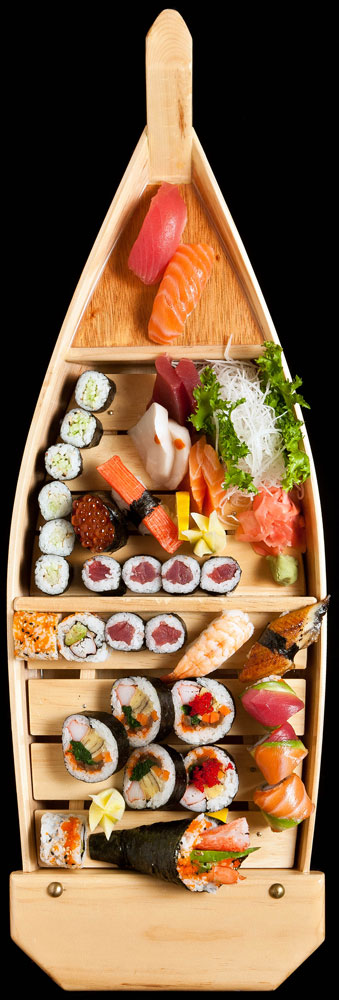Ever pick up something new and feel like you’re trying to read Greek?
In the case of a sushi menu, it’s Japanese, but the experience can be just as confusing. What’s the difference between sashimi, maki and nigiri? And how are you supposed to eat this stuff, anyway?
Sushi-Thai Cary, a “best of both worlds” Thai and Japanese cuisine authority for nearly 14 years, gave us a crash course in the oft-feared food.
The decisions begin when ordering. Most patrons at Sushi-Thai choose to enjoy sushi as a meal, but some prefer a smaller serving as an appetizer.
Assistant Manager Nat Jirasawad recommends the California roll for sushi first-timers. The roll of crabstick (imitation crab made from fish), avocado, cucumber, seaweed, sushi rice, roe and sesame seeds is cooked and contains primarily familiar ingredients. A tuna or spicy tuna roll would be a good choice for a second roll, or first venture into raw sushi.
Even veteran sushi fans need to pay careful attention to the menu, Jirasawad says. “Read the ingredients, because what you’re used to may not be the same.” For example, a dragon roll is common at many restaurants, but “each place will fill and dress it differently,” he said.
For the adventurous, selections like octopus, squid and sea urchin are available. Unagi, or eel, is a common sight on a sushi bar, yet seems to carry a bit of a reputation. “It’s not chewy like everyone thinks, Jirasawad said. “A soft meat with a smoky barbecue flavor,” the cooked fish is served warm, and topped with eel sauce, which is a reduction of soy sauce and sugar.
| Maki: Seaweed and rice roll with various fillings. Most rolls have seaweed on the outside with rice and filling inside, but some are wrapped inside-out. Select rolls are tempura battered and deep fried. | |
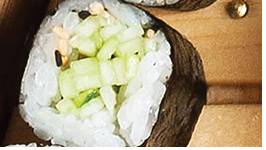 |
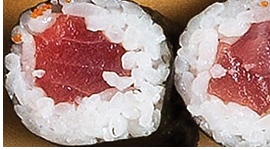 |
| Cucumber: Cucumber, rice and sesame seeds. | Tuna: Raw yellowfin tuna with rice and seaweed. A spicy tuna roll adds spicy sauce and scallions. |
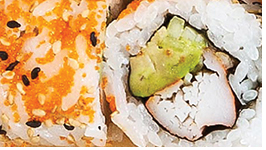 |
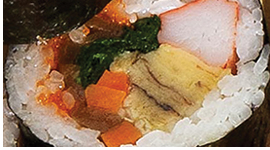 |
| California roll: Cooked crabstick, avocado, cucumber and spicy mayo rolled with sushi rice on outside, accented with smelt roe and sesame seeds. | Futomaki: Extra large roll with crabstick, egg omelet, asparagus, avocado, cucumber, spinach, carrot, dried gourd (kampyo), smelt roe (masago) and sesame seeds. |
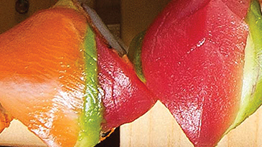 |
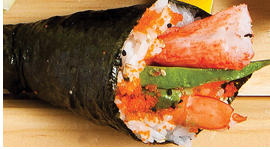 |
| Rainbow roll: California roll wrapped with three kinds of fish and avocado. | Temaki: Cone-shaped hand roll with a variety of fillings. Popular in Japan, but not commonly ordered in the U.S. |
|
Sashimi: The most basic form of sushi. Thin slices of very fresh raw fish. |
|
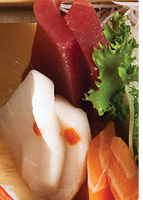 From top to bottom From top to bottom
|
|
|
Nigiri: Ball of rice topped with raw or cooked fish, fried egg omelet (tamago) or tofu (inari). |
|
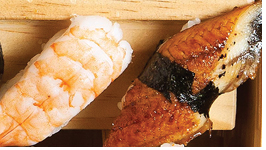 |
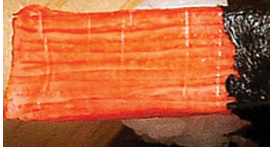 |
| From left to right.
Ebi:Cooked shrimp. Unagi: Barbecued eel. This type of sushi is served warm with a sweet eel sauce, and should be eaten quickly. |
Kani: Crabstick, imitation crab made of cooked fish. |


Ikura: Salmon roe, large fish eggs that pop in the mouth and give a distinctly salty flavor. Ikura rolls are sometimes requested topped with the yolk of a quail egg

Tobikko: Flying fish roe, available in red, green, black and yellow varieties with slightly different flavors. Red is most common. A Four Seasons roll at Sushi-Thai uses all four types, along with tuna, avocado, cucumber, scallions and sesame seeds
 Gari: Pickled ginger eaten to cleanse the palate when switching between types of sushi
Gari: Pickled ginger eaten to cleanse the palate when switching between types of sushi
Wasabi: Japanese horseradish, commonly mixed into soy sauce for dipping individual sushi pieces. Start with a modest amount and work up to your tolerance level.

Spicy mayo: A blend of Japanese mayonnaise, rice vinegar and spicy chili sauce. Used inside or on top of several types of sushi

Nori: Thin sheets of dried seaweed used to roll sushi



